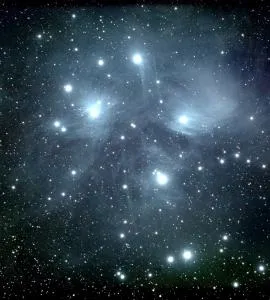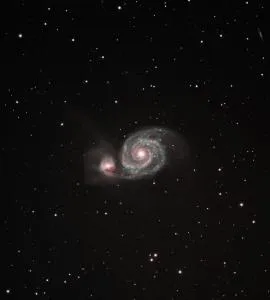The Rosette Nebula astrophoto taken with the Sharpstar 61EDPH III in SHO data only

We captured the awe-inspiring Rosette Nebula through the lens of the Sharpstar 61EDPH III telescope from the heart of the Ozarks in Missouri.
The Rosette Nebula, a vast region of ionized hydrogen gas located in the Monoceros constellation, is an emission nebula distinguished by its rose-like appearance. This celestial structure is approximately 5,000 light-years from Earth and spans about 130 light-years in diameter. At the heart of the Rosette Nebula lies the open star cluster NGC 2244, whose young, hot stars emit intense ultraviolet light, ionizing the surrounding gas and causing the nebula to glow. The nebula's intricate shapes and patterns are sculpted by the stellar winds and radiation from these stars, making it a fascinating subject for astrophotography.
The apparent size of the Rosette Nebular is about 1 degree in diameter in the sky. The full Moon is 1/2 of one degree. So, it's about twice the size of the full Moon!
In this recent astrophoto taken from the observatory with one of our smaller telescope instruments, we filtered the light to our telescope using Sulfer, Hydrogen-alpha, and Oxygen filter sets, often referred to as SHO.
Photographing the Rosette Nebula in the specific wavelengths of sulfur (SII), hydrogen-alpha (Ha), and oxygen (OIII) is significant for several reasons:
1. Enhanced Detail and Structure: Each of these emissions lines—SII, Ha, and OIII—corresponds to light emitted by sulfur, hydrogen, and oxygen ions, respectively, under the influence of ultraviolet light from stars. By isolating these wavelengths, photographers and astronomers can capture and emphasize different structural components and physical conditions within the nebula that might not be visible in broad-spectrum light. This can reveal intricate details of the nebula's filaments, cavities, and other features.
2. Scientific Insight: The distribution of these elements within the nebula provides valuable information about the processes of star formation and the dynamics of interstellar matter. For example, areas rich in hydrogen-alpha emission indicate regions of active star formation, while oxygen and sulfur emissions can highlight shock fronts and ionization boundaries. This information helps scientists understand the lifecycle of stars and the chemical enrichment of the interstellar medium.
3. Aesthetic Appeal: Photographs taken in these narrowband filters can be combined to create stunning images with enhanced contrast and color differentiation. This not only highlights the beauty of these celestial objects but also allows for a more detailed and varied interpretation of the data. The colors assigned to each element (often red for Ha, green for OIII, and blue for SII) can produce images of the Rosette Nebula with striking visual impact, making these scientific observations accessible and engaging to a wider audience.
In summary, photographing the Rosette Nebula in sulfur, hydrogen, and oxygen wavelengths offers a unique blend of scientific exploration and artistic expression, revealing the hidden details and beauty of our universe.

The Hubble Space Telescope and SHO data, why we use it.
The "Hubble Palette," also known as the Hubble Space Telescope Mapping or SHO (Sulfur, Hydrogen, Oxygen) palette, is a technique used in astrophotography and astronomical imaging to represent data from narrowband filters through specific color assignments. This technique was popularized by images produced by the Hubble Space Telescope, hence the name.
In the Hubble Palette:
- Sulfur-II (SII) emissions are mapped to the red channel.
- Hydrogen-alpha (Ha) emissions are assigned to the green channel.
- Oxygen-III (OIII) emissions are placed in the blue channel.
This color mapping does not correspond to the true colors of the nebulae as would be seen by the human eye but is chosen to highlight the differences in gas composition and structure within celestial objects. By using this technique, astronomers and astrophotographers can create images with striking contrasts and detailed structures that are otherwise invisible in natural color or broad-spectrum light.
The Hubble Palette reveals different physical properties and conditions within the photographed objects. For example, areas with strong sulfur emissions will appear red, regions with predominant hydrogen-alpha emissions will look green, and parts where oxygen-III emissions are strongest will be depicted in blue. This approach is particularly valuable in studying the composition, temperature variations, and dynamics of nebulae and other astronomical phenomena.
The aesthetic appeal and the ability to visually differentiate between various elements make the Hubble Palette a favored choice among astrophotographers, despite the fact that the colors do not represent the actual visible appearance of these celestial objects.

Rosette Nebula astrophoto details
Date: January 10th, 2024
Telescope: Sharpstar 61EDPH III 61 mm APO Refractor telescope, focal reducer (.75), 270mm FL and F/4.4
Mount: ZWO AM5
Camera: ZWO 2600MM, Temp= -20, Gain= 100 / ZWO filters
Guider: ZWO ASI 120 mini as the guide camera
Controller: ASI Air
Acquisition:
3 minute X 5 subs each of RGB.
5 minute X 12 of SHO
Combined acquisition time of
3 hours 45 minutes
Darks/Flats/Bias: (None)
Luminance: (None)
Processing: Pixinsight, Photoshop
Location: Missouri
Bortle Class Sky: 4

An Ozark explanation of the Rosette Nebula
Imagine you're lookin' out over them Ozark hills at night, and up in the sky, there's this giant cosmic cloud kinda shaped like a wild rose. That's the Rosette Nebula, a huge patch of space dust and gas light-years away. It's got its own spark because of a bunch of young, fiery stars right in its middle, making it glow all pretty-like. These stars are like the bonfire at the heart of it, lighting up the whole thing for us to see. It's one of those wonders of the night sky that makes you think about how vast and beautiful the universe is, beyond our own backwoods and clearings.
If you could hop in your truck and drive straight up to the Rosette Nebula, you'd be on quite the road trip. This nebula is about 5,000 light-years away. Now, a light-year is the distance light travels in a year, which is about 5.88 trillion miles. So, if your truck could fly through space at a steady 60 miles per hour, it'd take you around 10.5 trillion hours to get there. That's about 1.2 billion years of non-stop driving, give or take. You'd need a lot of snacks for that journey!
As for how bright it is, well, comparing the Rosette Nebula to a flashlight is like comparing the light of a huge bonfire to a firefly. From where we're sitting, it might not seem as bright because it's so darn far away, but up close, it's a whole different story. The nebula glows because of those young stars at its center, lighting up the gas and dust around them. But since it's spread out over a huge area in space, its light gets pretty diluted by the time it reaches us here on Earth. So, even though it's incredibly bright at its source, it looks faint to us, and you'd need a pretty good telescope to really appreciate its glow. Ain't no flashlight out there that can compete with the light of stars, especially not over such a grand scale.
About the Author

Meet Richard Harris, a passionate and dedicated astronomer who embarked on a cosmic journey at the age of 11 and has been reaching for the stars ever since. Born with an innate curiosity for the universe. Richard's fascination with astronomy ignited when he first gazed up at the night sky and felt an indescribable connection to the cosmos and creation. As a younger lad, Richard spent countless hours poring over astronomy books, studying constellations, and learning about the celestial wonders that grace our skies. In 2001, Richard invented the HyperTune telescope process, which has grown into the standard for German equatorial telescope mount tuning across the globe. He is also the founder of ScopeTrader, a global resource helping to grow the hobby of astronomy which started in 2002, and the CEO of Moonbeam software company, started in 2008. When he's not taking photos of our universe, you can find him with family, playing guitar, or traveling.











